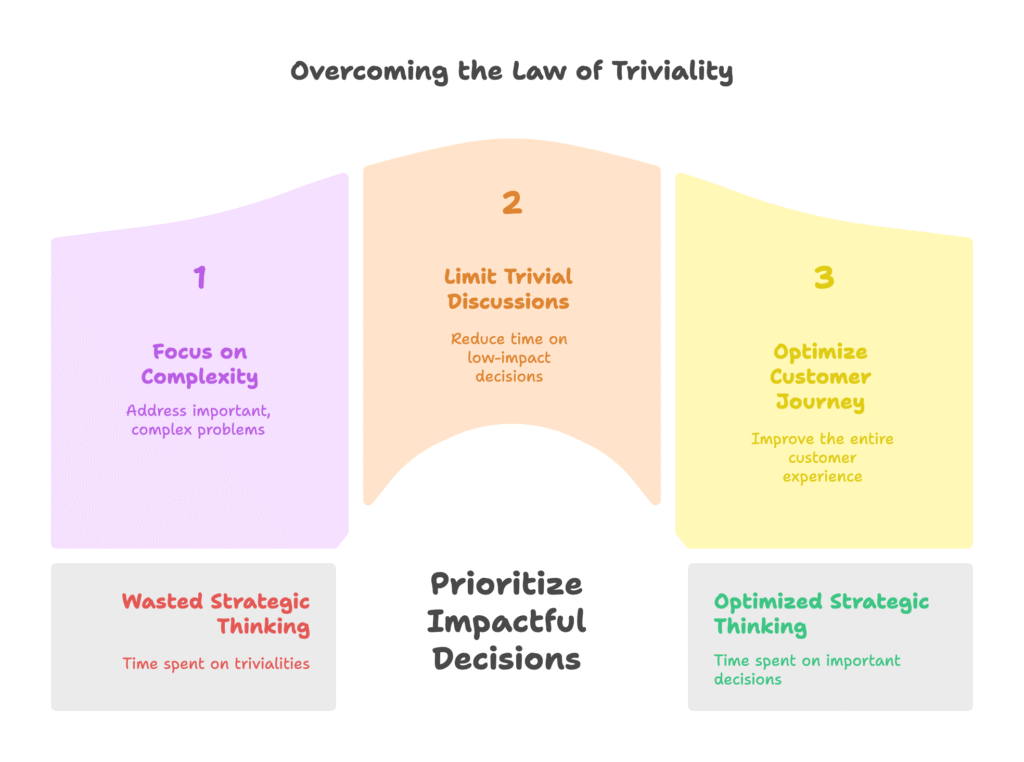Picture this: You’ve spent three hours in a meeting debating whether your “Add to Cart” button should be coral #FF7F50 or salmon #FA8072. Meanwhile, your conversion rates are stuck at 2.1%, and your competitors just launched a game-changing feature. Sound familiar?
Welcome to the world of bike-shedding – where we obsess over tiny details while ignoring the big picture that could actually transform our business.
If you’re running a Shopify store and feel like you’re always busy but not moving the needle, this article is your wake-up call. By the end, you’ll know exactly how to spot these time-wasting traps and redirect your energy toward the decisions that actually grow your revenue.
Ready to stop rearranging deck chairs on the Titanic? Let’s dive in.
What Is the Law of Triviality (And Why It’s Killing Your Store)
Let’s start with the basics. In this section, we’ll explore what the Law of Triviality really means and why it’s such a silent killer for Shopify businesses.

The Birth of Bike-Shedding
Back in 1957, a brilliant guy named C. Northcote Parkinson noticed something weird about committee meetings. He watched as these supposedly smart people would spend mere minutes discussing a multi-million dollar nuclear power plant but then spend hours debating the color of a bike shed that cost practically nothing.
Why? Simple. Everyone felt comfortable having an opinion about paint colors, but nuclear reactors? That required actual expertise most people didn’t have.
Parkinson’s insight became known as the Law of Triviality: “The time spent on any agenda item will be in inverse proportion to the sum involved.”
The Psychology Behind the Madness
But why do we fall into this trap? Three main reasons drive this behavior:
- Cognitive Accessibility: Our brains are lazy. Simple problems feel easier to solve, so we gravitate toward them like a moth to a flame.
- Competence Signaling: We all want to look smart. When everyone can have an opinion on something simple (like colors), we jump at the chance to contribute.
- Risk Avoidance: Complex decisions have real consequences. It’s safer to debate font choices than inventory management strategies.
The Hidden Cost to Your Business
Here’s the scary part: Research shows that businesses spend up to 45% of their meeting time on low-impact decisions. That’s nearly half your strategic thinking time going down the drain.
The real damage goes beyond wasted time:
- Decision Fatigue: Your mental energy gets depleted on trivial matters, leaving you too exhausted for important choices
- Strategic Neglect: While you’re perfecting product photos, competitors are optimizing their entire customer journey
- Team Frustration: Nothing kills motivation faster than endless debates about things that don’t matter
Now that we understand the enemy, let’s see how it shows up specifically in Shopify operations. Trust me, you’ll recognize these patterns immediately.
How Bike-Shedding Sabotages Your Shopify Store
Time for some tough love. In this section, we’ll examine the most common ways Shopify store owners waste precious time and energy on the wrong things.
The Classic Shopify Bike-Sheds
Every Shopify store owner has fallen into these traps at least once. Here are the biggest time-wasters and what you’re actually missing:
| What You’re Debating | What You’re Ignoring | Real Impact |
|---|---|---|
| Theme color palettes for hours | Conversion funnel optimization | Potential 18% revenue loss |
| Perfect app icons and names | Customer lifetime value strategy | 27% lower retention rates |
| Product photo minor details | Inventory turnover analysis | 32% higher carrying costs |
| Email template designs | Segmentation and personalization | 40% lower open rates |
| Button placement by pixels | Checkout flow simplification | 25% cart abandonment increase |
Where the Bottlenecks Really Happen
Bike-shedding doesn’t just happen in meetings. It creeps into every aspect of your operations:
- Team Meetings: Spending 80% of time on UI tweaks while strategic decisions get five-minute discussions
- Development Priorities: Building seventeen small features nobody asked for instead of one game-changing improvement
- Marketing Focus: Obsessing over brand aesthetics while your customer acquisition costs skyrocket
- App Selection: Researching apps for months instead of testing the top three for two weeks each
The True Financial Damage
Let’s talk dollars and cents. Bike-shedding hits your wallet in three ways:
- Opportunity Cost: Every hour spent on trivial decisions is an hour not spent on growth initiatives
- Decision Delay Costs: Markets move fast. While you’re debating details, opportunities disappear
- Implementation Inefficiencies: Poor prioritization leads to constant rework and wasted development cycles
Feeling the pain yet? Good. Because recognizing the problem is the first step to solving it. Now let’s build your defense system against bike-shedding.
Your Strategic Framework to Beat Bike-Shedding
Enough diagnosis – it’s time for the cure. This section will give you a practical framework to stop wasting time and start focusing on what actually moves your business forward.

The Decision Architecture That Changes Everything
First, we need to create a system that automatically filters important decisions from noise. Here’s your new decision-making structure:
The Impact-Effort Matrix
Before any decision, ask yourself two questions:
- Impact: How much could this affect my revenue in the next 6 months?
- Effort: How much time, money, and resources will this require?
Then apply the $10K Question: “Would this matter if it cost me $10,000?” If the answer is no, you’re probably bike-shedding.
Decision Tiers That Actually Work
Organize every decision into these three tiers:
- Tier 1 (Revenue impact >$10K): Full team discussion required. These decisions deserves serious time and multiple perspectives.
- Tier 2 (Revenue impact $1K-$10K): Owner decides with one trusted advisor’s input. Quick but thoughtful.
- Tier 3 (Revenue impact <$1K): Owner decides immediately. No meetings, no endless research.
Meeting Optimization for Shopify Teams
Your meetings are probably the biggest bike-shedding culprits. Here’s how to fix them:
Structure That Prevents Triviality
- Time-boxed items: High-impact decisions get more time, not the other way around
- Pre-reading requirements: Send background info 24 hours before complex decisions
- Default to 15-minute meetings: Force yourself to focus on what matters
Clear Role Definition
For every decision, identify:
- Decision Owner: One person with final authority (usually the store owner)
- Input Providers: People with specific expertise on this issue
- Informed Parties: People who need to know the outcome but don’t decide
Acceleration Tools You Can Use Today
Here are three techniques to implement immediately:
- The 5-15-80 Rule: Spend 5 minutes on updates, 15 minutes on tactical issues, and 80% of your time on strategic decisions
- Pre-Commitment Devices: Write your position on each agenda item before the meeting starts
- Parkinson’s Reversal: Always start with the most complex, important decisions when your energy is highest
Theory is nice, but you need specifics for your Shopify store. Let’s get practical with implementation strategies designed for e-commerce operations.
Shopify-Specific Implementation Strategies
Now we’re getting to the good stuff. This section translates our anti-bike-shedding framework into actionable steps specifically for your Shopify store.
Optimizing Your Admin Dashboard for Focus
Your Shopify dashboard is your command center. Let’s organize it to prevent triviality from creeping in:
The Metrics Hierarchy
Organize your metrics into three levels of importance:
- Primary Metrics (check daily): Conversion rate, average order value, inventory turnover
- Secondary Metrics (check weekly): Traffic sources, top product performance, customer acquisition cost
- Tertiary Metrics (check monthly): Social media engagement, email aesthetics, brand mention colors
If you’re checking tertiary metrics daily, you’re bike-shedding. Focus on what drives revenue.
Building Decision Support Systems
Set up automatic alerts for important changes:
- Conversion rate drops below 2%: This matters more than your homepage hero image
- Inventory running low on top products: This beats debating product description fonts
- Cart abandonment spikes above 75%: This trumps footer design discussions
Development Workflow That Prevents Bike-Shedding
Whether you’re coding yourself or working with developers, this framework keeps everyone focused:
Feature Prioritization Framework
Before building anything, every feature must pass this test:
- Revenue Impact Projection: How much additional monthly revenue could this generate?
- Implementation Effort: How many hours/days will this realistically take?
- ROI Timeline: When will this pay for itself?
No projection? No development.
Time-Boxing Your Development Resources
Allocate your development time (or budget) this way:
- 60% on strategic projects: Major features that could significantly impact revenue
- 30% on optimization work: Improving existing features based on data
- 10% on visual/cosmetic changes: Yes, only 10%. That’s all they deserve.
Team Structure That Supports Strategic Focus
Even small teams need clear decision-making protocols:
Decision Authority Maps
Create a simple document that shows who decides what:
- Store owner: All Tier 1 decisions, product strategy, major investments
- Marketing manager: Campaign decisions under $1K, content calendar
- Developer/designer: Implementation details, technical choices within approved projects
Resource Allocation Matrix
Align your spending with your priorities:
- High-impact projects: Get the budget they need, when they need it
- Low-impact improvements: Wait for leftover budget or batch with other small items
- Purely cosmetic changes: Only if you’ve already maximized revenue opportunities
Implementation without measurement is just wishful thinking. Let’s make sure your anti-bike-shedding efforts actually work.
Measuring Success: Anti-Bike-Shedding Metrics
You can’t improve what you don’t measure. This section will show you exactly how to track whether you’re actually focusing on what matters.
The Metrics That Matter
Forget vanity metrics. These three indicators will tell you if you’re beating bike-shedding:
Strategic Focus Index
Calculate the percentage of time spent on high-impact activities:
- Track time spent on Tier 1 decisions vs. total decision-making time
- Goal: 60-70% of your time on strategic issues
- If you’re below 50%, you’re still bike-shedding
Decision Velocity Rate
Measure how quickly you implement different types of decisions:
- Tier 1 decisions: Should be implemented within 2-4 weeks
- Tier 2 decisions: Should be implemented within 1 week
- Tier 3 decisions: Should be implemented immediately or the same day
Bike-Shed Detector
Track the correlation between meeting time and financial impact:
- High correlation = good: Important decisions get more discussion time
- Low correlation = bike-shedding: You’re spending equal time on everything
Measuring Intervention Effectiveness
Here’s how to know if your anti-bike-shedding efforts are working:
Before/After Analysis
Track these changes over 30, 60, and 90 days:
- Meeting efficiency: Average meeting duration vs. decisions made
- Strategic initiative completion rates: How many high-impact projects actually get finished?
- Revenue per decision hour: Total revenue growth divided by time spent on decisions
Team Feedback Mechanisms
Your team’s experience is just as important as the numbers:
- Decision satisfaction surveys: Do people feel their time is well-spent?
- Resource allocation perception: Do team members think resources go to the right places?
- Frustration indicators: Are people complaining about endless debates on trivial matters?
Numbers tell the story, but real examples drive the point home. Let’s look at actual stores that transformed their results by focusing on what matters.
Real Success Stories: Stores That Beat Bike-Shedding
Theory is nice, but results speak louder. Here are three real examples of Shopify stores that transformed their operations by focusing on impact over triviality.
DTC Fashion Brand: From Feature Frenzy to Strategic Focus
The Problem: This growing fashion brand was spending 70% of their development sprints on UI tweaks and minor feature additions. They had beautiful product pages but terrible conversion rates.
The Intervention: They implemented strict decision tiers and allocated 60% of resources to strategic projects. Instead of debating button colors, they focused on checkout optimization and personalization.
The Results: 3x revenue growth in 8 months. Their conversion rate jumped from 1.8% to 4.2%. Most importantly, they reduced decision-making time by 50% while achieving better outcomes.
Key Takeaway: Sometimes you need to ignore the small stuff to see the big picture.
Marketplace Optimization: From App Paralysis to Tool Mastery
The Problem: A home decor store spent 6 months researching and debating 18 different apps. They were paralyzed by choice and ended up using none of them effectively.
The Intervention: They adopted the “Rule of Three”: Pick the top 3 options, test each for 2 weeks, then commit to the winner. No more research, no more debates.
The Results: They deployed 3 core tools in 1 month that improved operational efficiency by 42%. Customer support time decreased by 35%, and inventory management became 60% more accurate.
Key Takeaway: Done is better than perfect. The best tool you actually use beats the perfect tool you never implement.
Multi-Brand Portfolio: From Color Debates to Customer Data
The Problem: A company with 4 brands was holding weekly meetings to debate cross-promotion color schemes and banner designs. Meanwhile, they had no unified customer data or meaningful cross-selling strategy.
The Intervention: They banned all visual discussions for 60 days and focused exclusively on customer data integration and automated cross-selling systems.
The Results: Deployed a unified customer data platform in 1 month. Cross-selling revenue increased by 180%. Customer lifetime value improved by 65%. And surprise – the “ugly” temporary banners converted better than the “beautiful” ones they’d been debating.
Key Takeaway: Your customers care more about relevant products than perfect color coordination.
Common Success Patterns
All these success stories share three key elements:
- Clear Decision Boundaries: They defined what deserved attention and what didn’t
- Implementation Speed: They valued quick action over perfect planning
- Measurement Focus: They tracked business results, not process perfection
Ready to join these success stories? Let’s create your step-by-step action plan.
Your Implementation Roadmap
Enough reading – it’s time for action. This final section gives you a concrete 180-day plan to eliminate bike-shedding from your Shopify operations.
Days 1-30: Quick Wins That Build Momentum
Start with these immediate changes that require no budget or complex planning:
Week 1: Meeting Revolution
- Restructure all meeting agendas: Put high-impact items first, time-box everything
- Implement the $10K Question: Ask it for every agenda item
- Cancel one recurring meeting: If it doesn’t directly impact revenue, it can probably go
Week 2: Decision Tier Implementation
- Categorize pending decisions: Sort everything into Tiers 1, 2, and 3
- Make all Tier 3 decisions immediately: Just pick and move on
- Schedule focused time for Tier 1 decisions: Give them the attention they deserve
Week 3-4: Dashboard Optimization
- Identify your primary metrics: Choose 3-5 that directly correlate with revenue
- Set up automated alerts: Let the data tell you what needs attention
- Hide or minimize tertiary metrics: Keep them accessible but not prominent
Days 31-90: Building Systematic Change
Now that you’ve built good habits, let’s create lasting systems:
Resource Reallocation (Days 31-45)
- Audit current projects: Cancel or pause anything that doesn’t meet Tier 1-2 criteria
- Reallocate development resources: Follow the 60-30-10 rule for strategic vs. optimization vs. cosmetic work
- Review app subscriptions: Keep tools that drive measurable results, cancel the rest
Decision Rights Framework (Days 46-60)
- Create decision authority maps: Write down who decides what
- Establish escalation protocols: Clear paths for decisions that cross boundaries
- Train team members: Make sure everyone understands the new system
Feedback Mechanism Establishment (Days 61-90)
- Implement weekly decision reviews: Track where time and attention are going
- Create team feedback channels: Regular check-ins on decision satisfaction
- Establish measurement protocols: Start tracking your anti-bike-shedding metrics
Days 91-180: Cultural Transformation
The final phase focuses on making strategic focus part of your DNA:
Reward System Alignment (Days 91-120)
- Recognize strategic thinking: Praise team members who identify high-impact opportunities
- Discourage bike-shedding: Gently redirect conversations that focus on trivial details
- Measure progress publicly: Share anti-bike-shedding metrics with the team
Training Program Development (Days 121-150)
- Create decision-making guidelines: Document your process for future team members
- Develop case studies: Use your own examples of good and bad decisions
- Regular skill building: Monthly training on strategic thinking and prioritization
Continuous Improvement Mechanism (Days 151-180)
- Quarterly decision audits: Review major decisions and their outcomes
- Process refinement: Adjust your framework based on what you learn
- Celebrate wins: Acknowledge when strategic focus leads to better results
Your First Action Steps
Don’t wait. Start today with these three immediate actions:
- List your current pending decisions: Categorize them into Tiers 1, 2, and 3
- Make three Tier 3 decisions right now: Just pick and move on
- Schedule focused time this week for your most important Tier 1 decision: Give it the attention it deserves
The path from bike-shedding to strategic focus isn’t complicated – it just requires discipline and the right framework. You now have both.
Ready to Focus on What Really Drives Sales?
While you’re optimizing your decision-making process, don’t forget about the decisions that directly impact your bottom line. Growth Suite helps Shopify merchants like you focus on what matters most: converting more visitors into customers.
Instead of guessing which visitors might buy, Growth Suite uses behavioral data to identify hesitant buyers and present them with personalized, time-limited offers. It’s strategic targeting that protects your brand while boosting conversions – exactly the kind of high-impact decision that deserves your attention.
Start your 14-day free trial and see how focusing on real conversion opportunities can transform your store’s performance.




